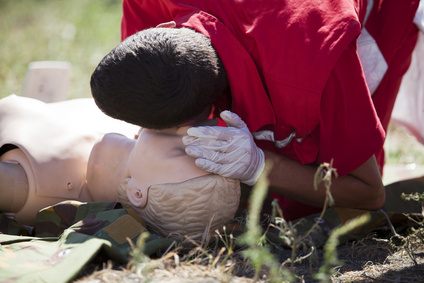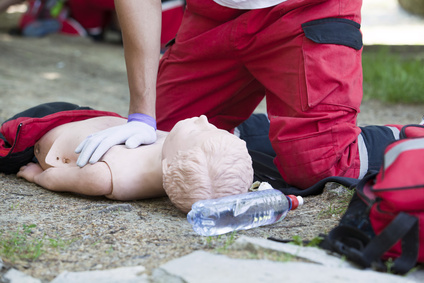When to Activate Emergency Response System
Witnessed Collapse: Follow the CPR steps for adults and adolescents.
Unwitnessed Collapse: Provide 2 minutes of CPR. Leave victim to activate the Emergency Response System and retrieve an AED (unless you can have someone else activate the response). Return and resume CPR and use an AED if it is available.
Child CPR (Age 1 Year to Puberty)
Scene Safety and Recognition of Cardiac Arrest: Check for safety and responsiveness, no breathing, and gasping. Check pulse for more than 5 seconds but within 10 seconds (breathing and pulse check can occur simultaneously).
Check Pulse: Check the pulse by placing two fingers on the carotid artery (press your index and 3rd finger on the side of the neck against the windpipe). You can also check the wrist by placing the same two fingers on the inside of the wrist below the thumb.
C is for Circulation – Child Compressions
Circulation: Chest compressions circulate the blood within the patient. It's important to place your hands correctly upon the patient’s chest. Chest Compression Tempo: Perform CPR while matching the tempo of the song "Staying Alive" while making sure to push hard and fast.
Compression-ventilation ratio without Advanced Airway
Make sure the child is resting upon a firm, solid surface. Before you begin compressions, determine if one hand could be used instead of two. One hand should be used for smaller children for safety reasons. Perform on the lower half of the breastbone (sternum). Do not lean on the child’s chest in between compressions and make sure the chest ultimately recoils. Limit all interruptions to less than 10 seconds while performing CPR.
It’s important to note: When performing chest compressions on a child you should compress about 2 inches (5 cm) (at least one third AP diameter of the chest). Do not exceed 1/2 the depth of the child’s circumference. It should be between a depth of 1/3 and 1/2. Make sure your hands are placed correctly upon the child’s chest. Follow the same steps when performing CPR on an adult and adolescents: 30 compressions and two breaths equaling a ratio of 30:2. Two Rescuers: Perform tasks simultaneously. Administer compressions over breathing 15:2.
Compression-ventilation ratio with Advanced Airway
- Continuous compressions at a rate of 100-120/min
- One breath every 6 seconds (10 breaths/min)
A is for Airway – Clear the Airway
Airway: Kneel beside the child the same way you would kneel beside an adult. Perform the three steps as you would with an adult. Tilt the chin and open the mouth while listening and feeling for any breathing for less than 10 seconds. Make sure nothing is blocking the airway. Proceed to the breathing technique if the child isn't showing signs of life.
B is for Breathing – Mouth-to-Mouth
Breathing: Make sure to perform the same breathing task upon the child as you would upon the adults and adolescents. Children’s lungs are much smaller than adults, so make sure to give a lesser breath when performing this task upon a child. After tilting the head and chin, squeeze the nose shut. Seal your mouth over the child’s mouth and perform the breathing task.
Remember, give one breath into the child’s lungs while making sure the child’s chest inflates. If the child’s chest doesn't rise, repeat the airway technique. After the chest inflates, perform compressions.
Once the breathing technique is applied, continue Circulation, Airway, Breathing (C-A-B’s).
Rescuers Should Never
- Compress slower than 100/min or faster than 120/min
- Compress in-depths less than 2 inches (5 cm) or more than 2.4 (6 cm)
- Lean on the victim’s chest during compressions
- Allow interruption during compressions more than 10 seconds
- Provide excessive ventilation during breathing task (i.e., excessive breathing with force or too many breaths)
- Check the environment and make sure it’s safe for rescuers and victims
- Remove any physical obstructions in the immediate area (i.e., belongings, debris, small pieces of furniture)
- Check responsiveness
- No breathing or only gasping (no normal breathing)
- Within 10 seconds – no positive pulse
- You can check for a pulse and breathing simultaneously in less than 10 seconds
- Witnessed collapse Leave the victim, if you’re alone without a mobile phone. Activate the emergency response system while retrieving an AED before performing CPR
- Unwitnessed collapse Give 2 minutes of CPR. Activate the emergency response system. Get an AED and return to the victim. Resume CPR and use the AED as soon as it is available.
- 1 rescuer 30:2
- 2 or more rescuers 15:2
- Chest compressions – 100-120/min
- Give one breath every 6 seconds (10 breaths/min)
- 100-120/min
- At least 1/3 AP diameter of chest
- About 2 inches (5 cm)
- One or two hands can be used (optional for small children)
- On the lower half of the breastbone (sternum)
- Make sure not to lean on the chest of the victim and allow a full recoil after each chest compression
- Compression interruptions should be limited to less than 10 seconds





